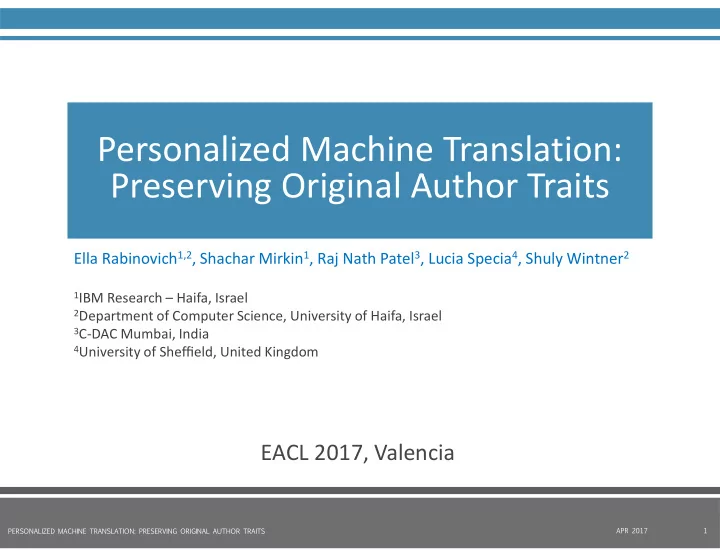

Personalized Machine Translation: Preserving Original Author Traits Ella Rabinovich 1,2 , Shachar Mirkin 1 , Raj Nath Patel 3 , Lucia Specia 4 , Shuly Wintner 2 1 IBM Research – Haifa, Israel 2 Department of Computer Science, University of Haifa, Israel 3 C-DAC Mumbai, India 4 University of Sheffield, United Kingdom EACL 2017, Valencia ������������������������������������������������������������������� �������� �
Background – Personalized Machine Translation � The language we produce reflects our personality – Demographics: gender, age, geography etc. – Personality: extraversion, agreeableness, openness, conscientiousness, neuroticism (the “Big Five”) � Authorial traits affect our perception of the content we face – We may have a preference to a specific authorial style � Personalized Machine Translation (PMT) – Preserving authorial traits in manual and machine translation (Mirkin et al., 2015) – Predicting user’s translation preference (Mirkin and Meunier, 2015) ������������������������������������������������������������������� �������� �
Background – Authorial Gender � Male and female speech differs, to an extent distinguishable by automatic classification (Koppel et al., 2002; Schler et al., 2006; Burger et al., 2011) – Male speakers use nouns and numerals more frequently � associated with the alleged “information emphasis” – Female prominent signals include verbs and pronouns � e.g., “we” as a marker of group identity ������������������������������������������������������������������� �������� �
Research Questions � Are the prominent authorial signals preserved through translation? – Human (a translator involved) and machine translation � Can machine-translation models be adapted to better preserve authorial traits? � Are authorial traits in translated text retained from the source? – Do they differ from those of the target language? � We focus on SMT adaptation to better preserve authorial gender markers through automatic translation ������������������������������������������������������������������� �������� �
Datasets � Europarl - proceedings of the European Parliament – Automatically annotated 1 for speaker gender and age using: � Wikidata (manually curated dataset) Michael Cramer instance of: human (Germany) sex or gender: male position held: member of the European parliament … � Genderize.io (based on person’s first name and country) � Alchemy vision (image classification for gender) – Estimated accuracy of gender annotation in the dataset is 99.8% � Based on an evaluation against the Wikidata ground truth 1 http://cl.haifa.ac.il/projects/pmt/ ������������������������������������������������������������������� �������� �
Datasets (cont.) � TED talks transcripts – English-French corpus of IWSLT 2014 Evaluation Campaign’s MT track � Annotated for speaker gender (Mirkin et al., 2015) gender / language pair en-fr fr-en en-de de-en Europarl # of sentences by M speakers 100K 67K 101K 88K # of sentences by F speakers 44K 40K 61K 43K additional (not annotated) data 1.7M 1.5M TED # of sentences by M speakers 140K # of sentences by F speakers 43K * the numbers refer to sentences originally uttered in the source language ������������������������������������������������������������������� �������� �
Personalized MT - Approach � Gender-aware SMT models – Personalization as a domain-adaptation task � Gender-specific model components (TM and LM) � Gender-specific tuning sets � Baseline model disregarding the gender information – A single TM and LM is built using male, female and unlabeled data – Tuning is done using a random sample of sentences ������������������������������������������������������������������� �������� �
Personalized MT Models � MT-PERS1: a single system with 3 TMs and 3 LMs trained on male (M), female (F) and additional unlabeled data Male TM Male LM Female LM Female TM Unlabeled LM Unlabeled TM � The model was tuned using the gender-specific tuning set – Resulting in 2 sub-models that differ in their tuning ������������������������������������������������������������������� �������� �
Personalized MT Models (cont.) � MT-PERS2: two separate systems, each one comprising gender-specific (M or F), as well as unlabeled TM and LM Male TM Male LM Female TM Female LM Unlabeled TM Unlabeled TM Unlabeled LM Unlabeled LM � Both models were tuned using the gender-specific tuning set ������������������������������������������������������������������� �������� �
MT Evaluation Results (BLEU) � Phrase-based SMT – Moses (Koehn et al., 2007) � Language modeling done using KenLM (Heafield, 2011) – 5-gram LMs with Kneser-Ney smoothing � Tuning with MERT model / language-pair en-fr fr-en en-de de-en MT-baseline 38.65 37.65 21.95 26.37 Europarl MT-PERS1 38.42 37.16 21.65 26.35 MT-PERS2 38.34 37.16 21.80 26.21 MT-baseline 33.25 TED MT-PERS1 33.19 MT-PERS2 33.16 Personalized models do not harm MT quality ������������������������������������������������������������������� �������� ��
Preserving Gender Traits – Evaluation � Binary (M vs F) classification of each model output – Human- and machine-translation � Features: frequencies of function words and POS-trigrams – Stylistic, content-independent features � Classification units: random chunks of 1K tokens – Inline with Schler et al., 2006 (classified blog posts) – Gender classification at small units, e.g., sentence, is practically impossible � Linear SVM classifier, 10-fold cross-validation evaluation ������������������������������������������������������������������� �������� ��
Preserving Gender Traits – Results � Binary classification using function words and top-1000 POS-trigrams language (-pair) accuracy (%) language (-pair) accuracy (%) en O 77.3 en O 80.4 fr O 81.4 en-fr HT 73.8 TED fr-en HT 75.0 en-fr MT-baseline 70.7 Europarl fr-en MT-baseline 77.6 en-fr MT-PERS1 77.2 fr-en MT-PERS1 81.4 en-fr MT-PERS2 77.7 fr-en MT-PERS2 80.0 en-fr HT 56.5 en-fr MT-baseline 60.1 en-fr MT-PERS1 62.8 en-fr MT-PERS2 65.3 ������������������������������������������������������������������� �������� ��
Preserving Gender Traits – Results � Binary classification using function words and top-1000 POS-trigrams language (-pair) accuracy (%) language (-pair) accuracy (%) en O 77.3 en O 80.4 fr O 81.4 en-fr HT 73.8 TED fr-en HT 75.0 en-fr MT-baseline 70.7 Europarl fr-en MT-baseline 77.6 en-fr MT-PERS1 77.2 fr-en MT-PERS1 81.4 en-fr MT-PERS2 77.7 fr-en MT-PERS2 80.0 en-fr HT 56.5 en-fr MT-baseline 60.1 en-fr MT-PERS1 62.8 en-fr MT-PERS2 65.3 ������������������������������������������������������������������� �������� ��
Preserving Gender Traits – Results � Binary classification using function words and top-1000 POS-trigrams language (-pair) accuracy (%) language (-pair) accuracy (%) en O 77.3 en O 80.4 fr O 81.4 en-fr HT 73.8 TED fr-en HT 75.0 en-fr MT-baseline 70.7 Europarl fr-en MT-baseline 77.6 en-fr MT-PERS1 77.2 fr-en MT-PERS1 81.4 en-fr MT-PERS2 77.7 fr-en MT-PERS2 80.0 en-fr HT 56.5 en-fr MT-baseline 60.1 en-fr MT-PERS1 62.8 en-fr MT-PERS2 65.3 ������������������������������������������������������������������� �������� ��
Recommend
More recommend